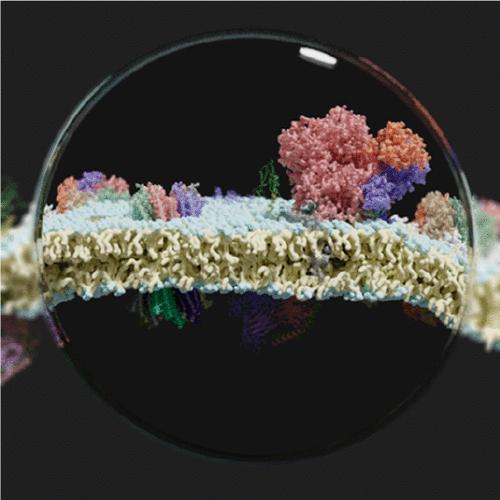当前位置:
X-MOL 学术
›
Chem. Rev.
›
论文详情
Our official English website, www.x-mol.net, welcomes your
feedback! (Note: you will need to create a separate account there.)
Membranes under the Magnetic Lens: A Dive into the Diverse World of Membrane Protein Structures Using Cryo-EM
Chemical Reviews ( IF 51.4 ) Pub Date : 2022-07-18 , DOI: 10.1021/acs.chemrev.1c00837 Sarah J Piper 1, 2 , Rachel M Johnson 1, 2 , Denise Wootten 1, 2 , Patrick M Sexton 1, 2
Chemical Reviews ( IF 51.4 ) Pub Date : 2022-07-18 , DOI: 10.1021/acs.chemrev.1c00837 Sarah J Piper 1, 2 , Rachel M Johnson 1, 2 , Denise Wootten 1, 2 , Patrick M Sexton 1, 2
Affiliation

|
Membrane proteins are highly diverse in both structure and function and can, therefore, present different challenges for structure determination. They are biologically important for cells and organisms as gatekeepers for information and molecule transfer across membranes, but each class of membrane proteins can present unique obstacles to structure determination. Historically, many membrane protein structures have been investigated using highly engineered constructs or using larger fusion proteins to improve solubility and/or increase particle size. Other strategies included the deconstruction of the full-length protein to target smaller soluble domains. These manipulations were often required for crystal formation to support X-ray crystallography or to circumvent lower resolution due to high noise and dynamic motions of protein subdomains. However, recent revolutions in membrane protein biochemistry and cryo-electron microscopy now provide an opportunity to solve high resolution structures of both large, >1 megadalton (MDa), and small, <100 kDa (kDa), drug targets in near-native conditions, routinely reaching resolutions around or below 3 Å. This review provides insights into how the recent advances in membrane biology and biochemistry, as well as technical advances in cryo-electron microscopy, help us to solve structures of a large variety of membrane protein groups, from small receptors to large transporters and more complex machineries.
中文翻译:

磁透镜下的膜:使用冷冻电镜深入了解膜蛋白结构的多样化世界
膜蛋白在结构和功能上都高度多样化,因此对结构测定提出了不同的挑战。它们作为信息和分子跨膜转移的看门人,对细胞和生物体具有重要的生物学意义,但每一类膜蛋白都可能对结构确定造成独特的障碍。历史上,已经使用高度工程化的构建体或使用较大的融合蛋白来研究许多膜蛋白结构以提高溶解度和/或增加粒径。其他策略包括解构全长蛋白质以靶向较小的可溶性结构域。晶体形成通常需要这些操作来支持 X 射线晶体学或避免由于蛋白质子结构域的高噪声和动态运动而导致的较低分辨率。然而,膜蛋白生物化学和冷冻电子显微镜的最新革命现在提供了在接近天然条件下解析大型 >1 兆道尔顿 (MDa) 和小型 <100 kDa (kDa) 药物靶标的高分辨率结构的机会,通常可以达到 3 Å 左右或以下的分辨率。这篇综述深入探讨了膜生物学和生物化学的最新进展以及冷冻电子显微镜的技术进步如何帮助我们解决各种膜蛋白组的结构,从小型受体到大型转运蛋白和更复杂的机器。
更新日期:2022-07-18
中文翻译:

磁透镜下的膜:使用冷冻电镜深入了解膜蛋白结构的多样化世界
膜蛋白在结构和功能上都高度多样化,因此对结构测定提出了不同的挑战。它们作为信息和分子跨膜转移的看门人,对细胞和生物体具有重要的生物学意义,但每一类膜蛋白都可能对结构确定造成独特的障碍。历史上,已经使用高度工程化的构建体或使用较大的融合蛋白来研究许多膜蛋白结构以提高溶解度和/或增加粒径。其他策略包括解构全长蛋白质以靶向较小的可溶性结构域。晶体形成通常需要这些操作来支持 X 射线晶体学或避免由于蛋白质子结构域的高噪声和动态运动而导致的较低分辨率。然而,膜蛋白生物化学和冷冻电子显微镜的最新革命现在提供了在接近天然条件下解析大型 >1 兆道尔顿 (MDa) 和小型 <100 kDa (kDa) 药物靶标的高分辨率结构的机会,通常可以达到 3 Å 左右或以下的分辨率。这篇综述深入探讨了膜生物学和生物化学的最新进展以及冷冻电子显微镜的技术进步如何帮助我们解决各种膜蛋白组的结构,从小型受体到大型转运蛋白和更复杂的机器。











































 京公网安备 11010802027423号
京公网安备 11010802027423号